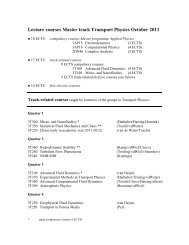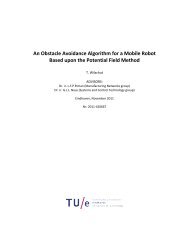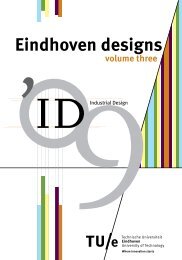Education guide 'Eindhoven designs' - Technische Universiteit ...
Education guide 'Eindhoven designs' - Technische Universiteit ...
Education guide 'Eindhoven designs' - Technische Universiteit ...
You also want an ePaper? Increase the reach of your titles
YUMPU automatically turns print PDFs into web optimized ePapers that Google loves.
Eindhoven designs / volume two<br />
57<br />
enables students to describe relationships<br />
between parameters resulting in systems<br />
behaviour. The next step is mathematical<br />
modelling to describe this behaviour in<br />
mathematical relationships. For engineers,<br />
understanding and learning mathematical<br />
models is the foundation for simulation and<br />
optimisation. These enable exploration of<br />
the desired and undesired capabilities of<br />
technological mediation that occurs in the<br />
complex interplay between user and artefact,<br />
as explained in chapter two. Instead of using<br />
trial and error methods, students need to<br />
explore systematically and get insight: what<br />
are the crucial properties of especially highly<br />
dynamic and intelligent systems and products<br />
that benefit from mathematical modelling?<br />
During the design process the results of these<br />
types of modelling can be compared with<br />
prototype tests and analyses.<br />
Integrating Technology<br />
Being competent in integrating<br />
technology means being able to explore,<br />
visualise, create and demonstrate<br />
innovative concepts and experiences<br />
using technology, as well as analysing<br />
the technical and economic feasibility<br />
of complex designs in which technology<br />
is integrated. Moreover, one needs to<br />
understand scientific writings and be<br />
able to communicate with engineers and<br />
researchers of another discipline.<br />
Designing interactive and intelligent systems,<br />
and building prototypes requires training<br />
in choosing sensors and actuators, objectoriented<br />
design, algorithms, circuits and<br />
mechanisms, and integrating them in the<br />
overall competency of designing. Next to<br />
synthesising and concretising, developing<br />
one’s analytical and abstraction skills to<br />
determine the technical and economic<br />
feasibility of a design can be done through<br />
informed judgements through calculations,<br />
maths items and appropriate math tools, as<br />
well as generating sufficient knowledge that<br />
enables you to read further and go into depth<br />
on technological, design-related issues.<br />
Designers typically work in multi-disciplinary<br />
teams. This, and the fact that intelligent<br />
systems can overstretch at some point the<br />
skills and knowledge of Industrial Design<br />
students, requires students to understand<br />
scientific writings and be able to communicate<br />
with engineers and researchers of another<br />
discipline. Thus understanding E, I and W as<br />
disciplines and being able to cooperate with<br />
the E, I and W engineers, which may require<br />
reading specifications and datasheets,<br />
documenting hardware and software, and<br />
finally awareness of computer science and<br />
artificial intelligence.<br />
Ideas and Concepts<br />
Develop visions, innovative ideas and<br />
concepts through creativity techniques,<br />
experimentations and the translation of<br />
research.<br />
Ideas and concepts are initiated through<br />
different ways of doing and thinking<br />
according to your attitude, influences and<br />
experiences such as: empathic thinking<br />
(concerned with feeling and sensing your way),<br />
associative thinking (compares and makes<br />
connections with different objects, places and<br />
experiences), thinking with your body and

















